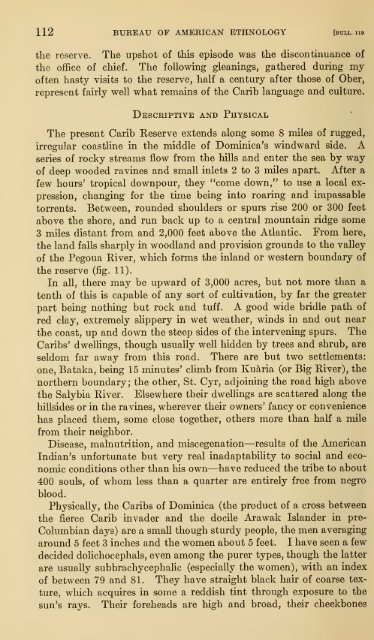Create successful ePaper yourself
Turn your PDF publications into a flip-book with our unique Google optimized e-Paper software.
112 BUREAU OF AMERICAN ETHNOLOGY [bull. 119<br />
the reserve. <strong>The</strong> upshot <strong>of</strong> this episode was the discontinuance <strong>of</strong><br />
the <strong>of</strong>fice <strong>of</strong> chief. <strong>The</strong> following gleanings, gathered during my<br />
<strong>of</strong>ten hasty visits to the reserve, half a century after those <strong>of</strong> Ober,<br />
represent fairly well what remains <strong>of</strong> the Carib language and culture.<br />
Descriptive and Physical<br />
<strong>The</strong> present Carib Keserve extends along some 8 miles <strong>of</strong> rugged,<br />
irregular coastline in the middle <strong>of</strong> <strong>Dominica</strong>'s windward side. A<br />
series <strong>of</strong> rocky streams flow from the hills and enter the sea by way<br />
<strong>of</strong> deep wooded ravines and small inlets 2 to 3 miles apart. After a<br />
few hours' tropical downpour, they "come down," to use a local expression,<br />
changing for the time being into roaring and impassable<br />
torrents. Between, rounded shoulders or spurs rise 200 or 300 feet<br />
above the shore, and run back up to a central mountain ridge some<br />
3 miles distant from and 2,000 feet above the Atlantic. From here,<br />
the land falls sharply in woodland and provision grounds to the valley<br />
<strong>of</strong> the Pegoua River, which forms the inland or western boundary <strong>of</strong><br />
the reserve (fig. 11).<br />
In all, there may be upward <strong>of</strong> 3,000 acres, but not more than a<br />
tenth <strong>of</strong> this is capable <strong>of</strong> any sort <strong>of</strong> cultivation, by far the greater<br />
part being nothing but rock and tuff. A good wide bridle path <strong>of</strong><br />
red clay, extremely slippery in wet weather, winds in and out near<br />
<strong>The</strong><br />
the coast, up and down the steep sides <strong>of</strong> the intervening spurs.<br />
<strong>Caribs</strong>' dwellings, though usually well hidden by trees and shrub, are<br />
seldom far away from this road. <strong>The</strong>re are but two settlements:<br />
one, Bataka, being 15 minutes' cUmb from Kultria (or Big River), the<br />
northern boundary; the other, St. Cyr, adjoining the road high above<br />
the Salybia River.<br />
Elsewhere their dwellings are scattered along the<br />
hillsides or in the ravines, wherever their owners' fancy or convenience<br />
has placed them, some close together, others more than half a mile<br />
from their neighbor.<br />
Disease, malnutrition, and miscegenation—results <strong>of</strong> the American<br />
Indian's unfortunate but very real inadaptability to social and economic<br />
conditions other than his own—have reduced the tribe to about<br />
400 souls, <strong>of</strong> whom less than a quarter are entirely free from negro<br />
blood.<br />
Physically, the <strong>Caribs</strong> <strong>of</strong> <strong>Dominica</strong> (the product <strong>of</strong> a cross between<br />
the fierce Carib invader and the docile Arawak Islander in pre-<br />
Columbian days) are a small though sturdy people, the men averaging<br />
around 5 feet 3 inches and the women about 5 feet. I have seen a few<br />
decided dolichocephals, even among the purer types, though the latter<br />
are usually subbrachycephalic (especially the women), with an index<br />
<strong>of</strong> between 79 and 81. <strong>The</strong>y have straight black hair <strong>of</strong> coarse texture,<br />
which acquires in some a reddish tint through exposure to the<br />
sun's rays. <strong>The</strong>ir foreheads are high and broad, their cheekbones

















